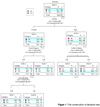Abstract
Purpose
This study was done to identify protective factors which predict internet game addition in middle school students using data mining decision tree analysis.
Methods
The participants were 557 (Male=233, Female=324) middle school students from G city. Data were collected using structured questionnaires from March, 25 to May, 4, 2013, and analyzed using the descriptive analysis, t-test, ANOVA, decision tree, using SPSS 20.0 program.
Results
The result of this research showed the prediction model for protective factors related to internet game addiction. Causative factors included gender, family support and father's attitude as the family protective factor, and planning ability as the personal protective factor. Level of accuracy of the decision tree was 70.6%.
Figures and Tables
References
1. Korea Agency for Digital Opportunity and Promotion (KR). Research of internet addiction family counsel program development. Korea Agency for Digital Opportunity and Promotion (KR);2012. p. 72. (NIA publication; no. NIA IV-RER-1208).
2. Kwak KJ. A review of researches of the impact of computer game and children's and adolescent's development. Korean J Psychol Soc Issues. 2004; 10:147–175.
3. Livingstone S, Haddon L. Risky experiences for children online: charting European research on children and the internet. Child and Soc. 2008; 22(4):314–323. http://dx.doi.org/10.1111/j.1099-0860.2008.00157.x.

4. Ryu JA. Research trend in internet game addiction of youth in Korea: analysis of journals. Korean J Play Ther. 2008; 11(1):87–99.
5. Kim SY, Cho KL, Hwang JH. High school student's internet addiction by their interpersonal relations disposition. Korean J Youth Stud. 2007; 14(4):39–57.
6. Lee CS, Kweon YR, Kim SJ. The impact of school bullying victim and depression on suicidal ideation of middle school students. J Korean Acad Psychiatr Ment Health Nurs. 2007; 16(1):32–40.
7. Rink E, Tricker R. Promoting healthy behaviors among adolescents: a review of the resiliency literature. Am J Health Stud. 2005; 20(1):39–46.
8. Ostaszewski K, Zimmerman MA. The effects of cumulative risks and promotive factors on urban adolescent alcohol and others drug use: a longitudinal study of resiliency. Am J Community Psychol. 2006; 38:237–249. http://dx.doi.org/10.1007/s10464-006-9076-x.
9. Joo AR. Correlations among internet games addition, self-esteem and physical health in middle school students. J Korean Acad Community Health Nurs. 2007; 18(2):331–339.
10. Koun NS, Lee JH. The influential factors related to internet game addiction among male middle school students in Ulsan: focusing on learning motivation, school adjustment, self-control, self-esteem. J Korean Soc of Sch Health. 2013; 25(1):13–26.
11. Choi TS, An JY. The effect of psychological environment of home and interpersonal relationship skills on adolescent's internet game addiction. J Korean Soc Comput Game. 2010; 23:131–140.
12. Kim KS, Kim KH. A prediction model for internet game addiction in adolescents: using a decision tree analysis. J Korean Acad Nurs. 2010; 40(3):378–388. http://dx.doi.org/10.4040/jkan.2010.40.3.378.

13. Yang NM, Lee JY. The analysis of boy and girl elementary school student's attachment, game addiction and adjustment. Korean J Couns. 2007; 8(2):639–655.

14. Park SH. A study on the relationship among ego resilience, failure tolerance and school adjustment of elementary school children. J Elem Educ. 2009; 16(2):59–81.
15. Piramuthu S. Input data for decision tree. Expert Syst Appl. 2008; 34(2):1220–1226. http://dx.doi.org/10.1016/j.eswa.2006.12.030.
16. Lee HC, Ahn CY. Development of the internet game addiction diagnostic scale. Korean J Health Psychol. 2002; 7(2):211–239.
17. Park HS. The developmental mechanism of school resilience of Korean adolescents in poverty. Korean J Youth Stud. 1998; 5(3):147–165.
18. Kweon YR, Park MS. Effects of school adjustment on higher grade elementary school students' internet game addiction: focused on gender difference. J Korean Acad Psychiatr Ment Health Nurs. 2012; 21(2):99–107. http://dx.doi.org/10.12934/jkpmhn.2012.21.2.99.

19. Park HS, Jung SY. Construction of the addiction prevention core competency model for preventing addictive behavior in adolescents. J Korean Acad Nurs. 2013; 43(6):714–725. http://dx.doi.org/10.4040/jkan.2013.43.6.714.

20. Byun SH, Kim JM. The relationships among children's/adolescent's frequency levels of playing internet games, motives for playing internet games and adaptation to school. J Korean Home Manage Assoc. 2007; 25(2):47–58.
21. Shin HM, Yoo MS. The influences of children's stress-coping styles on the risk of internet gaming addiction through school-related adjustments. Korean J Play Ther. 2007; 10(3):45–59.
22. Jo AM, Bang HJ. The effects of parent, teacher, and friend social support on adolescent's game addiction. Korean J Youth Stud. 2003; 10(1):249–275.
23. Snyder KA. A vocabulary of motives: understanding how parents define quality time. J Marriage Fam. 2007; 69(2):320–340. http://dx.doi.org/10.1111/j.1741-3737.2007.00368.x.

24. Park BK, Shin SM, Lee HJ. A study on the relationship between types of teen preferred internet game and internet game addiction, parent-adolescent communication, and self-control. Korean J Health Psychol. 2012; 17(3):659–676.

25. Yang MK, Oh WO. Effects of the internet game addiction prevention educational program on self-control and time spent on internet games by elementary school students. J Korean Acad Child Health Nurs. 2007; 13(3):282–290.
26. Stetina BU, Kothgassner OD, Lehenbauer M, Kryspin-Exner I. Beyond the fascination of online-games: probing addictive behavior and depression in the world of online-gaming. Comput Human Behav. 2011; 27(1):473–479. http://dx.doi.org/10.1016/j.chb.2010.09.015.

27. Valcke M, Bonte S, De Wever B, Rots I. Internet parenting styles and the impact on Internet use of primary school children. Comput Educ. 2010; 55(2):454–464. http://dx.doi.org/10.1016/j.compedu.2010.02.009.

28. Fleming MJ, Greentree S, Cocotti-Muller D, Elias K, Morrison S. Safety in cyberspace: adolescent's safety and exposure online. J Youth Soc. 2006; 38(2):135–154. http://dx.doi.org/10.1177/0044118X06287858.
29. Kweon YR. The comparative analysis of predictors of suicidal ideation on middle school students using decision tree and logistic regression. J Korean Data Anal Soc. 2010; 12(6b):3103–3115.
30. Ko CH, Yen JY, Liu SC, Huang CF, Yen CF. The associations between aggressive behaviors and Internet addiction and online activities in adolescents. J Adolesc Health. 2009; 44(6):598–605. http://dx.doi.org/10.1016/j.jadohealth.2008.11.011.





 PDF
PDF ePub
ePub Citation
Citation Print
Print






 XML Download
XML Download